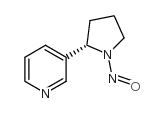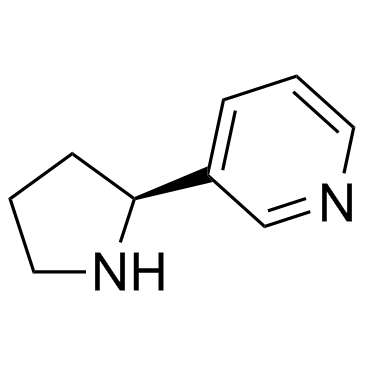16543-55-8
| 中文名 | N-亚硝基降烟碱 |
|---|---|
| 英文名 | n'-nitrosonornicotine |
| 中文别名 | N-亚硝基去甲烟碱 |
| 英文别名 |
N-NITROSONORNICOTINE
nitrosonornicotine NNN |
| 密度 | 1.28g/cm3 |
|---|---|
| 沸点 | 154ºC at 0.2 MM HG |
| 熔点 | 47ºC |
| 分子式 | C9H11N3O |
| 分子量 | 177.20300 |
| 闪点 | 177.3ºC |
| 精确质量 | 177.09000 |
| PSA | 45.56000 |
| LogP | 1.83780 |
| 外观性状 | 白色晶体 |
| 折射率 | 1.642 |
| 储存条件 | -20°C, 干燥, 充氩 |
| 分子结构 | 1、 摩尔折射率:49.83 2、 摩尔体积(m3/mol):137.8 3、 等张比容(90.2K):371.5 4、 表面张力(dyne/cm):52.7 5、 极化率(10-24cm3):19.75 |
| 计算化学 | 1、疏水参数计算参考值(XlogP):1.1 2、氢键供体数量:0 3、氢键受体数量:4 4、可旋转化学键数量:1 5、互变异构体数量: 6、拓扑分子极性表面积(TPSA):45.6 7、重原子数量:13 8、表面电荷:0 9、复杂度:186 10、同位素原子数量:0 11、确定原子立构中心数量:0 12、不确定原子立构中心数量:1 13、确定化学键立构中心数量:0 14、不确定化学键立构中心数量:0 15、共价键单元数量:1 |
| 更多 | 1.性状:未确定 2.密度(g/mL,25/4℃):未确定 3.相对蒸汽密度(g/mL,空气=1):未确定 4.熔点(ºC):未确定 5.沸点(ºC,常压):未确定 6.沸点(ºC,5.2kPa):未确定 7.折射率:未确定 8.闪点(ºC):未确定 9.比旋光度(º):未确定 10.自燃点或引燃温度(ºC):未确定 11.蒸气压(kPa,25ºC):未确定 12.饱和蒸气压(kPa,60ºC):未确定 13.燃烧热(KJ/mol):未确定 14.临界温度(ºC):未确定 15.临界压力(KPa):未确定 16.油水(辛醇/水)分配系数的对数值:未确定 17.爆炸上限(%,V/V):未确定 18.爆炸下限(%,V/V):未确定 19.溶解性:未确定 |
|
Section 1. Chemical Product and Company Identification N'-Nitrosonornicotine Common Name/ Trade Name N'-Nitrosonornicotine Section 3. Hazards Identification Potential Acute Health Effects Hazardous in case of ingestion. Slightly hazardous in case of skin contact (irritant), of eye contact (irritant), of
inhalation. Potential Chronic HealthCARCINOGENIC EFFECTS: Classified 2B (Possible for human.) by IARC. EffectsMUTAGENIC EFFECTS: Mutagenic for mammalian somatic cells. Mutagenic for bacteria and/or yeast. TERATOGENIC EFFECTS: Not available. DEVELOPMENTAL TOXICITY: Not available. Repeated or prolonged exposure is not known to aggravate medical condition. Section 4. First Aid Measures Eye ContactCheck for and remove any contact lenses. In case of contact, immediately flush eyes with plenty of water for at least 15 minutes. Get medical attention if irritation occurs. Skin ContactWash with soap and water. Cover the irritated skin with an emollient. Get medical attention if irritation develops. Serious Skin ContactNot available. InhalationIf inhaled, remove to fresh air. If not breathing, give artificial respiration. If breathing is difficult, give oxygen. Get medical attention. Serious InhalationNot available. IngestionDo NOT induce vomiting unless directed to do so by medical personnel. Never give anything by mouth to an unconscious person. If large quantities of this material are swallowed, call a physician immediately. Loosen tight clothing such as a collar, tie, belt or waistband. Serious IngestionNot available. Section 5. Fire and Explosion Data Flammability of the Product May be combustible at high temperature. Auto-Ignition Temperature Not available. Flash PointsNot available. Flammable LimitsNot available. These products are carbon oxides (CO, CO2), nitrogen oxides (NO, NO2...). Products of Combustion Fire Hazards in Presence of Slightly flammable to flammable in presence of heat. Various Substances Explosion Hazards in Presence Risks of explosion of the product in presence of mechanical impact: Not available. of Various SubstancesRisks of explosion of the product in presence of static discharge: Not available. Fire Fighting MediaSMALL FIRE: Use DRY chemical powder. and InstructionsLARGE FIRE: Use water spray, fog or foam. Do not use water jet. Special Remarks onNot available. Fire Hazards Special Remarks on Explosion Not available. Hazards N'-Nitrosonornicotine Section 6. Accidental Release Measures Small SpillUse appropriate tools to put the spilled solid in a convenient waste disposal container. Finish cleaning by spreading water on the contaminated surface and dispose of according to local and regional authority requirements. Large SpillUse a shovel to put the material into a convenient waste disposal container. Finish cleaning by spreading water on the contaminated surface and allow to evacuate through the sanitary system. Section 7. Handling and Storage PrecautionsKeep away from heat. Keep away from sources of ignition. Ground all equipment containing material. Do not breathe dust. Wear suitable protective clothing. If you feel unwell, seek medical attention and show the label when possible. Keep away from incompatibles such as oxidizing agents. StorageKeep container tightly closed. Keep container in a cool, well-ventilated area. Do not store above 0°C (32°F). Freeze. Section 8. Exposure Controls/Personal Protection Engineering ControlsUse process enclosures, local exhaust ventilation, or other engineering controls to keep airborne levels below recommended exposure limits. If user operations generate dust, fume or mist, use ventilation to keep exposure to airborne contaminants below the exposure limit. Personal ProtectionSafety glasses. Lab coat. Dust respirator. Be sure to use an approved/certified respirator or equivalent. Gloves. Personal Protection in Case of Splash goggles. Full suit. Dust respirator. Boots. Gloves. A self contained breathing apparatus should be used a Large Spillto avoid inhalation of the product. Suggested protective clothing might not be sufficient; consult a specialist BEFORE handling this product. Exposure LimitsNot available. Section 9. Physical and Chemical Properties Physical state and appearance Solid.OdorNot available. Not available. Taste Molecular Weight177.2 g/mole Yellow. (Light.) Color pH (1% soln/water)Not available. Boiling PointNot available. Melting Point43°C (109.4°F) - 45 C. Critical TemperatureNot available. Specific GravityNot available. Not applicable. Vapor Pressure Vapor DensityNot available. Not available. Volatility Odor ThresholdNot available. Water/Oil Dist. Coeff.Not available. Ionicity (in Water)Not available. Dispersion PropertiesNot available. SolubilityNot available. N'-Nitrosonornicotine Section 10. Stability and Reactivity Data The product is stable. Stability Instability TemperatureNot available. Excess heat, incompatible materials Conditions of Instability Reactive with oxidizing agents. Incompatibility with various substances CorrosivityNot available. Special Remarks onNot available. Reactivity Special Remarks onNot available. Corrosivity PolymerizationWill not occur. Section 11. Toxicological Information Routes of EntryInhalation. Ingestion. Toxicity to AnimalsLD50: Not available. LC50: Not available. Chronic Effects on Humans CARCINOGENIC EFFECTS: Classified 2B (Possible for human.) by IARC. MUTAGENIC EFFECTS: Mutagenic for mammalian somatic cells. Mutagenic for bacteria and/or yeast. Other Toxic Effects onHazardous in case of ingestion. HumansSlightly hazardous in case of skin contact (irritant), of inhalation. Special Remarks onNot available. Toxicity to Animals Special Remarks onMay cause cancer. Chronic Effects on Humans May affect genetic material (mutagenic). Special Remarks on otherAcute Potential Health Effects: Toxic Effects on HumansSkin: Causes skin irritation. Eyes: Causes eye irritation. Inhalation: Can cause respiratory tract irritation. Ingestion: No acute health effects are known at this time. Chronic Potential Health Effects: Ingestion: Repeated or prolonged ingestion may cause cancer. It may affect the liver. Section 12. Ecological Information EcotoxicityNot available. Not available. BOD5 and COD Possibly hazardous short term degradation products are not likely. However, long term degradation products may Products of Biodegradation arise. Toxicity of the ProductsThe product itself and its products of degradation are not toxic. of Biodegradation Special Remarks on theNot available. Products of Biodegradation N'-Nitrosonornicotine Section 13. Disposal Considerations Waste DisposalWaste must be disposed of in accordance with federal, state and local environmental control regulations. Section 14. Transport Information DOT ClassificationNot a DOT controlled material (United States). Not applicable. Identification Not applicable. Special Provisions for Transport DOT (Pictograms) Section 15. Other Regulatory Information and Pictograms California prop. 65: This product contains the following ingredients for which the State of California has found to Federal and State cause cancer, birth defects or other reproductive harm, which would require a warning under the statute: Regulations N'-Nitrosonornicotine California prop. 65 (no significant risk level): N'-Nitrosonornicotine: 0.0005 mg/day (value) California prop. 65: This product contains the following ingredients for which the State of California has found to cause cancer which would require a warning under the statute: N'-Nitrosonornicotine Illinois toxic substances disclosure to employee act: N'-Nitrosonornicotine Pennsylvania RTK: N'-Nitrosonornicotine Minnesota: N'-Nitrosonornicotine Massachusetts RTK: N'-Nitrosonornicotine New Jersey: N'-Nitrosonornicotine New Jersey spill list: N'-Nitrosonornicotine California Director's List of Hazardous Substances: N'-Nitrosonornicotine SARA 313 toxic chemical notification and release reporting: N'-Nitrosonornicotine CaliforniaCalifornia prop. 65: This product contains the following ingredients for which the State of California has found Proposition 65to cause cancer which would require a warning under the statute: N'-Nitrosonornicotine Warnings Other RegulationsNot available. WHMIS (Canada) CLASS D-2A: Material causing other toxic effects (VERY TOXIC). Other Classifications DSCL (EEC)R40- Limited evidence of aS36/37- Wear suitable protective clothing and carcinogenic effect.gloves. Health Hazard HMIS (U.S.A.)2 National Fire Protection 1 Flammability 1 Association (U.S.A.) Fire Hazard 2 0 Reactivity Health Reactivity 0 Specific hazard Personal Protection E WHMIS (Canada) (Pictograms) N'-Nitrosonornicotine DSCL (Europe) (Pictograms) TDG (Canada) (Pictograms) ADR (Europe) (Pictograms) Protective Equipment Gloves. Lab coat. Dust respirator. Be sure to use an approved/certified respirator or equivalent. Wear appropriate respirator when ventilation is inadequate. SECTION 16 - ADDITIONAL INFORMATION N/A |
CHEMICAL IDENTIFICATION
HEALTH HAZARD DATAACUTE TOXICITY DATA
MUTATION DATA
|
| 危险品运输编码 | UN 2810 |
|---|---|
| 包装等级 | III |
| 危险类别 | 6.1(b) |
| 海关编码 | 2933990090 |
|
~% 
16543-55-8 |
| 文献:v. Braun; Weissbach Chemische Berichte, 1930 , vol. 63, p. 2018,2026 |
| 海关编码 | 2933990090 |
|---|---|
| 中文概述 | 2933990090. 其他仅含氮杂原子的杂环化合物. 增值税率:17.0%. 退税率:13.0%. 监管条件:无. 最惠国关税:6.5%. 普通关税:20.0% |
| 申报要素 | 品名, 成分含量, 用途, 乌洛托品请注明外观, 6-己内酰胺请注明外观, 签约日期 |
| Summary | 2933990090. heterocyclic compounds with nitrogen hetero-atom(s) only. VAT:17.0%. Tax rebate rate:13.0%. . MFN tariff:6.5%. General tariff:20.0% |


